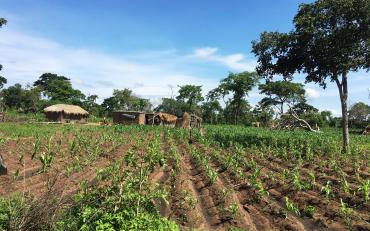By Romie Goedicke, Senior Expert Green Economy, IUCN Netherlands Committee
This blog was first posted on www.iucn.nl on Tuesday 29 May 2018
Having your feet in the mud is a Dutch expression used to describe a situation that requires you to be hands-on. When you work for IUCN NL this is sometimes a more literal experience. This blog is about how we connect sustainable landscape activities to financial institutions in Tanzania. In other words: how I went from getting my feet stuck in the mud under the blistering Tanzanian sun to wearing high heels at the launch of the Sustainable Banking Principles in Dar es Salaam – in a mere 24 hours.
Inclusive Green Growth
But let’s take one step back first. Tanzania aspires to become a middle-income country by 2025 through industrialization, economic transformation and development. Since 2007, the country has seen an average annual growth of over 6%, which has improved human wellbeing and increased life expectancy.
One of the ways this growth has been steered is through the creation of the Southern Agricultural Growth Corridor of Tanzania (SAGCOT), which connects the rich agricultural lands of South Tanzania to the port of Dar es Salaam. This public private partnership intends to mobilize $2.1 billion in new private sector agribusiness investments, backed by $1.3 billion in public sector investments used for building new infrastructure. All this is done with the aim to achieve rapid growth in smallholder agriculture.
However, this also poses an important challenge: how can we realize growth that does not deplete natural resources, or causes severe habitat loss for wildlife? How can we ensure ecosystems do not collapse under the pressure caused by the steep rise in economic developments? As the Dutch Ambassador to Tanzania, Jeroen Verheul, puts it: "It is not about the level of growth, but about the quality of growth. We need to create growth that is both green and inclusive."
"We need to create growth that is both green and inclusive."
To help Tanzania overcome this challenge, SUSTAIN initiative supports Tanzania to do exactly this: to facilitate inclusive and climate resilient greening of growth in the Ihemi-Kilombero and Sumbawanga cluster within the SAGCOT corridor.
Within the context of the SUSTAIN program, IUCN NL focuses on green finance: on the one hand, we aim to mobilize more capital to make sustainable initiatives within the SAGCOT corridor happen. And on the other hand, we influence the financial institutions to ensure that the money invested in SAGCOT is used with respect for sustainability principles. This makes Tanzania a powerful test case for bridging the gap between demand and supply of finance.
Lifting landscape investment to the next level
So let’s start with our bottom-up work.
What happens, in the Kilombero landscape for instance, when funding is needed across multiple projects in one landscape? What we see is that those competing claims are often larger than the actual land that is available. Within the landscape, wind power, watershed service and sugar cane development need to be combined. How do multiple stakeholders effectively manage finance and mitigate conflicts?
In response to this issue, creative solutions are needed to figure out investment design that generate financial, environmental and social values.
The Landscape Investment and Finance Tool, developed by Eco-Agriculture and IUCN NL, can help ‘lift’ the haze on this matter. LIFT includes a set of three modules, helping landscape leaders develop and prioritize investment cases, pursue suitable investors and assemble an efficient finance strategy for their landscape priorities.
In collaboration with the African Wildlife Federation and PBL Netherlands Environmental Assessment Agency, we used LIFT to identify financeable investments within the Ihemi-Kilombero area. This is an important step towards bridging the gap to institutional investors, from the demand perspective.
Raising the bar for financial institutions
At the other side of this funnel IUCN NL also works with financial institutions. Most important issues in Tanzania are related to climate change and water scarcity, especially affecting the agricultural sector. While agricultural lending represents the majority of lending in Tanzania, there are currently no standards that address non-financial risks such as related to ESG factors. If these investors were to set clear criteria on how their investments impact nature, this would hugely stimulate the green and inclusive development of SAGCOT.
"If these investors were to set clear criteria on how their investments impact nature, this would hugely stimulate the green and inclusive development of SAGCOT."
Embedding this within the core business processes of financial institutions is not easy, but an important step was taken at a recent breakfast meeting with executives from all Tanzanian banks – where I found myself switching my sandals for high heels. There, together with the Association of Investors for Sustainable Development (VBDO) and the CEO Roundtable of Tanzania (CEOrt), the financial institutions agreed to develop Tanzania Sustainable Finance Principles.
During the meeting Ineke Bussemaker CEO of NMB, stated "As a sector we need to work together. We need the leaders to share their experience and help the others to follow in their steps." Her words were complemented by the words of the CEO of Barclays Bank Abdi Mohamed “We need smart policies that make sure that people and nature are well taken care off.”
Muddy waters
What did I learn from this experience? First of all, having your feet stuck in the mud – or stuck in high heels – is not so bad. If you want to see change happen you sometimes have to get your feet dirty. To learn we need to all step out of our own comfort zones. And we need people to show us the way.
The added value of the work of IUCN NL is to bring these different components together. Mud is earth mixed with water, IUCN NL is the moisture bringing the various parts together. And we look forward to continue this role in bringing across growth that is both green and inclusive in Tanzania.
